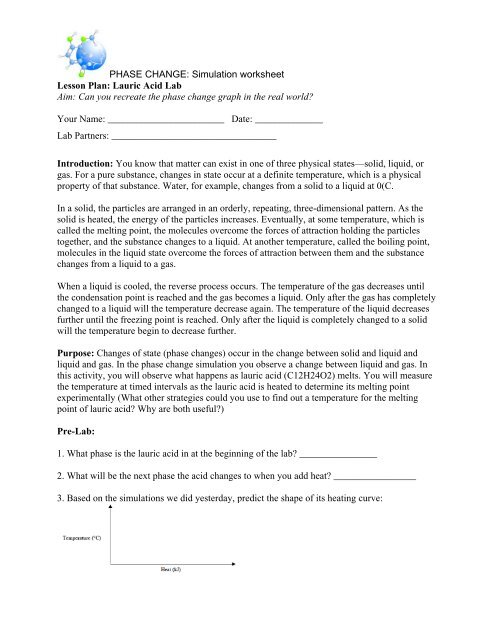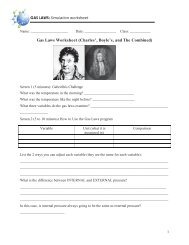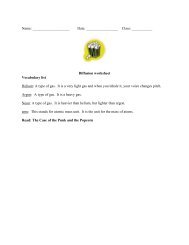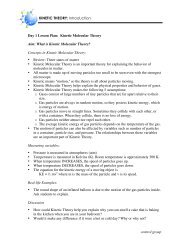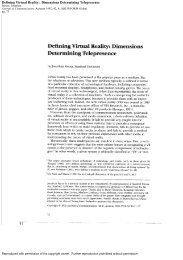PHASE CHANGE
PHASE CHANGE
PHASE CHANGE
You also want an ePaper? Increase the reach of your titles
YUMPU automatically turns print PDFs into web optimized ePapers that Google loves.
<strong>PHASE</strong> <strong>CHANGE</strong>: Simulation worksheet<br />
Lesson Plan: Lauric Acid Lab<br />
Aim: Can you recreate the phase change graph in the real world?<br />
Your Name: ________________________ Date: ______________<br />
Lab Partners: __________________________________<br />
Introduction: You know that matter can exist in one of three physical states—solid, liquid, or<br />
gas. For a pure substance, changes in state occur at a definite temperature, which is a physical<br />
property of that substance. Water, for example, changes from a solid to a liquid at 0(C.<br />
In a solid, the particles are arranged in an orderly, repeating, three-dimensional pattern. As the<br />
solid is heated, the energy of the particles increases. Eventually, at some temperature, which is<br />
called the melting point, the molecules overcome the forces of attraction holding the particles<br />
together, and the substance changes to a liquid. At another temperature, called the boiling point,<br />
molecules in the liquid state overcome the forces of attraction between them and the substance<br />
changes from a liquid to a gas.<br />
When a liquid is cooled, the reverse process occurs. The temperature of the gas decreases until<br />
the condensation point is reached and the gas becomes a liquid. Only after the gas has completely<br />
changed to a liquid will the temperature decrease again. The temperature of the liquid decreases<br />
further until the freezing point is reached. Only after the liquid is completely changed to a solid<br />
will the temperature begin to decrease further.<br />
Purpose: Changes of state (phase changes) occur in the change between solid and liquid and<br />
liquid and gas. In the phase change simulation you observe a change between liquid and gas. In<br />
this activity, you will observe what happens as lauric acid (C12H24O2) melts. You will measure<br />
the temperature at timed intervals as the lauric acid is heated to determine its melting point<br />
experimentally (What other strategies could you use to find out a temperature for the melting<br />
point of lauric acid? Why are both useful?)<br />
Pre-Lab:<br />
1. What phase is the lauric acid in at the beginning of the lab? ________________<br />
2. What will be the next phase the acid changes to when you add heat? _________________<br />
3. Based on the simulations we did yesterday, predict the shape of its heating curve:


